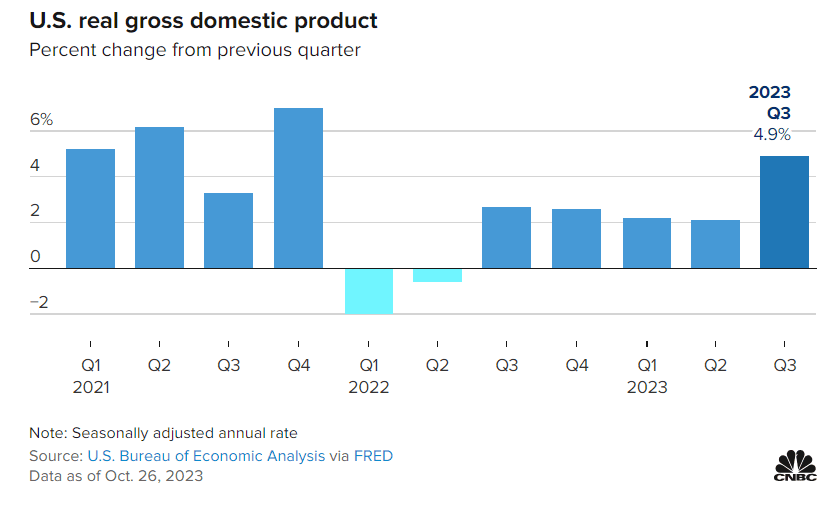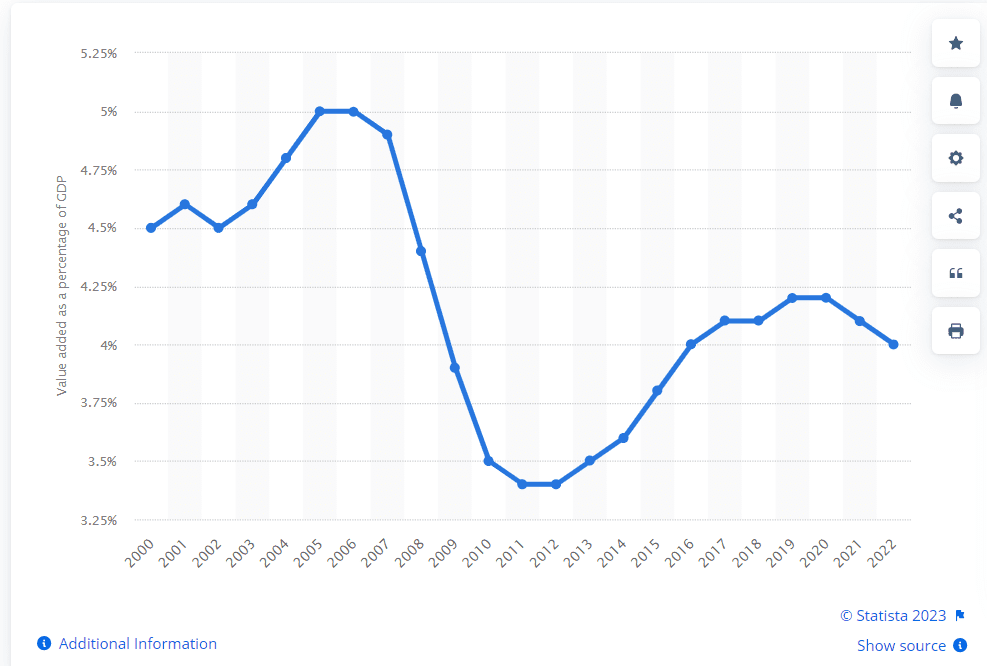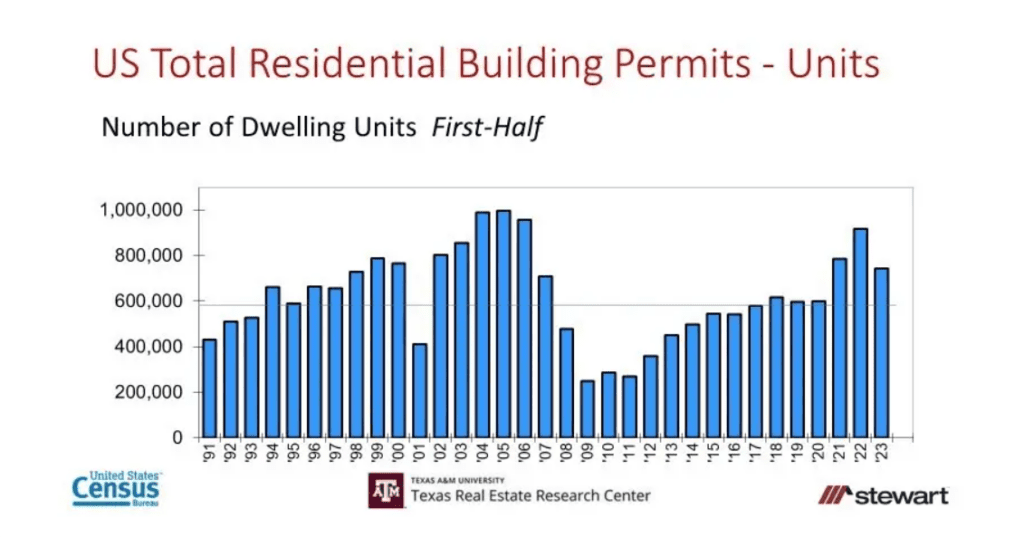
GDP Growth Suggests We’ve Avoided Recession: What Does It Mean For Construction Activity?
The pulse of an economy beats in the numbers of its Gross Domestic Product (GDP). These figures reflect the economic health of a nation, impacting everything from job markets to consumer spending. In the latest GDP report, we’ve witnessed encouraging signs of growth, offering a beacon of hope for multiple industries, including construction.
The significance of a robust GDP cannot be overstated. It’s a reflection of a thriving economy, driven by various contributing factors. In this blog post, we’ll explore the recent GDP report, understand the implications of GDP growth for different sectors and delve into how this economic expansion is poised to positively affect the construction industry.
Related: Visualizing Planned Construction for Site Selection.
Understanding the Recent GDP Report
A Recap of Key Findings in the GDP Report
The most recent GDP report is a compelling story of economic resurgence. In the face of various challenges, the economy has demonstrated resilience and managed to grow at a 4.9% annual pace in Q3 2023, compared to only a 2.1% growth rate in Q2 2023. Let’s take a moment to recap some key findings from the report to set the stage for our discussion.
Related: Economic Growth Spurs Opportunities in the CRE Industry.
1. Overview of GDP Growth Rate and Its Implications
The GDP growth rate is a primary indicator of a nation’s economic well-being. It measures the increase in the overall value of goods and services produced within a country’s borders over a specific period. In the most recent report, we’ve seen a significant uptick in this growth rate. The higher the GDP growth, the more buoyant the economy.
A robust GDP growth rate is a testament to a strong and vibrant economy. It reflects increasing economic activity, consumer confidence and a flourishing job market. A higher GDP growth rate indicates that the nation is creating more wealth and opportunities for its citizens.
2. Factors Contributing to the Positive GDP Growth
GDP growth is a complex interplay of various factors. These include consumer spending, business investments, government expenditure and net exports. In the recent report, several elements have contributed to the positive GDP growth:
- Consumer Spending: When consumers have confidence in the economy, they tend to spend more. Increased spending, in turn, boosts businesses and leads to job creation. Consumer spending on all goods in 2023 increased from 0.5% in Q2 to 4.8% in Q3.
- Business Investments: Companies expand and invest in their operations during times of economic growth. This spurs innovation and drives economic prosperity. Residential investments jumped from -2.2% in Q2 all the way to 3.9% in Q3.
- Government Expenditure: The government plays a significant role in shaping the economic landscape by investing in infrastructure, healthcare and education, among other sectors. Keeping with the increasing trend, government expenditures went up from 3.3% in Q2 to 4.6% in Q3.
- Net Exports: International trade is another vital component of GDP. When a country exports more than it imports, it contributes positively to GDP growth. Total net exports made the biggest jump, going from -9.3% in Q2 up to a whopping 6.2% in Q3.
See more details and data for factors that affected GDP going back to Q4 2019.
Related: How to Find Single-Family Developers.
How Various Sectors Have Contributed to the Economic Expansion
This GDP report isn’t just a number; it’s a mosaic of different industries, each painting its own part of the picture. Let’s take a closer look at how 4 sectors that have contributed to this economic expansion.
1. Technology and Innovation: The tech sector has been a driving force in recent economic growth. The digital revolution has transformed how we live and work, contributing significantly to GDP through software, hardware and the innovation it brings.
Related: Why Big Tech’s Data Center Expansion is Shaped by Planned Construction Data.
2. Manufacturing and Industrial Output: Industries related to manufacturing and industrial production have seen increased demand. A boost in production has not only fueled economic growth but also opened up opportunities for construction projects tied to factory expansions and renovations.
Related: Top Single-Family Builders.
3. Energy and Infrastructure: The push for cleaner and more efficient energy solutions, coupled with infrastructure investments, has created a ripple effect in the construction sector. These projects often require extensive construction work, from building new wind farms to revamping aging infrastructure.
Related: Top Hotel Developers.
4. Real Estate and Housing: A thriving real estate market, driven by lower interest rates and increasing demand for housing, has set the stage for a surge in construction projects, from residential complexes to commercial properties.
Related: Top Multifamily Developers in the US.
In the context of this discussion, it’s essential to highlight the crucial role that the construction industry plays in contributing to and benefiting from this economic resurgence. See the top retail architects here.
GDP’s Impact on the Construction Industry
Exploring the Relationship Between GDP and Construction
The connection between a growing GDP and the construction industry is both intricate and symbiotic. As the economy flourishes, so does the demand for construction projects. Understanding this relationship is pivotal to appreciating the potential benefits for the construction sector.
How a Growing Economy Drives Construction Projects
Economic growth brings a multitude of opportunities. When consumers are confident, they’re more inclined to invest in new homes, and businesses are more likely to expand their operations. Both of these activities lead to construction projects.
A booming economy also fosters a robust job market, which, in turn, fuels the need for commercial and residential spaces. Construction becomes the answer to this demand, playing a pivotal role in shaping the urban and suburban landscapes.
The Role of Consumer Spending and Business Investments
A significant chunk of GDP growth can be attributed to consumer spending and business investments. As consumers and businesses spend more, construction projects ranging from housing developments to commercial spaces and industrial facilities become essential to accommodate this growth.
The construction industry, therefore, enjoys a positive domino effect from increased consumer and business activity, further solidifying its position as a growth-inducing sector.
How GDP Growth Influences Construction Project Starts

Value added by the construction industry as a share of gross domestic product in the United States from 2000 to 2022. Source: Statista.
Increased Demand for Commercial and Residential Spaces
A thriving economy translates to increased demand for both commercial and residential spaces. New businesses sprout, existing ones expand and more people seek to invest in homeownership. This upsurge in demand directly leads to an increase in construction project starts.
For instance, businesses might need more office space, retailers require larger storefronts and individuals look to buy new homes or renovate existing ones. These developments create a wealth of opportunities for construction companies in multi/single-family, CRE, hotel and other markets.
See all of our Market Vision Reports with insightful construction data, trends and analytics here.
Infrastructure Development Opportunities
As GDP surges, governments often allocate funds for significant infrastructure projects. These can range from road expansions and bridge reconstructions to the construction of public facilities such as schools and hospitals. The construction industry plays a central role in these initiatives, enjoying a boost in project starts due to increased government expenditure.
Infrastructure projects not only provide revenue to construction companies but also improve the overall quality of life for citizens, thus fostering further economic growth.
How GDP Change Affects Construction Permits

Source: Stewart
Fluctuations in GDP play a pivotal role in influencing the issuance of construction permits. A robust GDP often corresponds to increased consumer confidence, business investments and government spending. These factors collectively stimulate demand for new construction projects, ranging from residential developments to commercial spaces and infrastructure initiatives. During periods of economic growth, authorities are more inclined to grant construction permits to meet the rising demand, facilitating the expansion of urban landscapes and infrastructure.
Conversely, in economic downturns, a decrease in GDP can lead to a reduction in construction permits as demand dwindles, and stakeholders become more risk-averse. Understanding the intricate dance between GDP and construction permits is crucial for industry professionals, enabling them to adapt strategies and capitalize on opportunities in dynamic economic climates.
How Construction Backlogs Change During a Recession
During a recession, the construction industry often experiences a significant shift in construction backlogs. As economic uncertainties and reduced consumer spending take center stage, construction projects may be delayed or put on hold. The decline in demand for new projects and the tightening of budgets can lead to a backlog of existing projects that struggle to secure funding or move forward. Construction firms may find themselves grappling with a backlog of projects in various stages, from planning to execution.
The uncertainty surrounding the economy during a recession can create a hesitancy among stakeholders to initiate new construction endeavors, causing a backlog to accumulate as projects face delays or cancellations. Navigating through these challenging times requires strategic planning and adaptability within the construction industry to weather the storm of a recession and emerge stronger on the other side.
Related: How to Get Construction Leads.
Leveraging BuildCentral to Find Construction Project Leads and Location Analytics
BuildCentral: Get Construction Leads and Location Analytics
Now that we’ve explored the positive impact of GDP growth on the construction industry, it’s time to introduce you to an invaluable resource for construction professionals—BuildCentral. We understand that staying ahead in a competitive industry like construction requires access to the right information and leads.
BuildCentral is a trusted leader in the field of construction project data. Our mission is to empower construction professionals with the insights and leads they need to thrive in the ever-evolving industry. With a wealth of experience and a commitment to providing accurate and up-to-date information, BuildCentral has become a go-to resource for businesses looking to expand their horizons.
As the construction industry gears up for a period of growth, it’s essential to have the right tools and resources at your disposal. BuildCentral is your key to seizing the opportunities that the positive GDP report has presented to the construction sector. Don’t miss out on these prospects; sign up today and supercharge your construction projects with the power of reliable data and leads from BuildCentral.
GDP Growth is Good for Construction
In this blog post, we’ve explored the symbiotic relationship between economic growth, as reflected in the recent GDP report and the construction industry. As GDP expands, so does the demand for construction projects, creating a wealth of opportunities for construction professionals. The connection between these two factors is undeniable, and it’s a connection that can be leveraged to take your construction business to new heights.
We’ve seen how a growing economy leads to increased demand for both commercial and residential spaces, as well as infrastructure development projects. This surge in demand is directly translated into a rise in construction project starts. From building new homes to expanding commercial spaces and undertaking major infrastructure projects, the construction industry becomes the backbone of economic expansion.
The positive GDP report is a beacon of hope for the construction industry, and we encourage you to make the most of this opportunity. Be proactive in leveraging this economic climate to your advantage, and ensure that you’re well-equipped with the right information and leads to thrive in the evolving construction landscape.
As the construction sector continues to grow in response to the positive economic outlook, remember that BuildCentral is your trusted partner in this journey. We’re here to provide you with the resources and data you need to succeed, and we look forward to being a part of your construction business’s success story.
Don’t miss out on the surge of construction opportunities that GDP growth is offering!
Read more about construction news and find valuable construction project data here.






